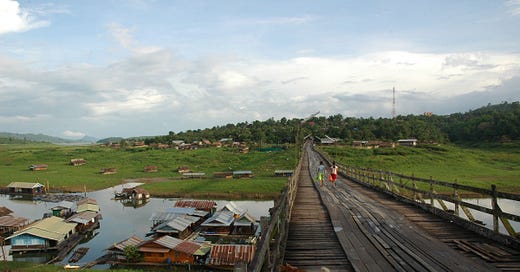If you’re killing time in Bangkok, Ko Samet to the east or Kanchanaburi to the west are the logical options. I say go west, break it with a night or two in Kanchanaburi, but then keep going—to Sangkhlaburi. Spitting distance from the Burmese border, it’s an ideal diversion from the Thai capital.
I grab a morning minibus from Kanchanaburi for the roughly three and a half hour run west along Route 323. Given the minibus speed I try to keep my eyes shut, but I pry them open as we head west by Sai Yok then Khao Laem National Parks. The last 45 minutes of the drive is just stunning, with the lake running out to the left. Then it all screeches to a halt by the market in town—just in time for a quick bite for lunch.
In the past I’d hit Burmese Inn—for years the cheapest spot in town—but it was looking poor on a previous visit, so instead I head to another backpacker stalwart, P Guesthouse. It is a newer place and has decent rooms and friendly staff. The real selling point though, is its lawn terrace which has excellent lake views across to the Mon village.
Moody weather. Photo: Stuart McDonald.
Set on the rim of a reservoir, the lake splits the town. The more typical Thai town is to one side and the Mon village and their impressive temples are on the other. Resorts (including some quite fancy ones) and guesthouses are flung out around the reservoir’s banks.
Traditionally a Karen town, an inflow of Thai and Mon settlers gives it a diverse vibe. This is reflected not just in the people, but also in their houses, temples, and food. This diversity came together in 2013 when Sangkhlaburi’s wooden bridge collapsed. People of all ethnicities joined forces to piece together a floating bamboo replacement. A permanent new bridge opened the following year.
The height of the lake varies by the season. With the light getting long, I hire a small boat to take me out to the remains of the original town. It takes us about 30 minutes to get there, and it is eerie as we pass stands of long dead trees.
All broken down at Wat Samprasob. Photo: Stuart McDonald.
Little remains, but some of Wat Samprasob still stands, pieces of a broken Buddha piled in front. It is interesting, and photogenic, but the true pleasure is just being out on the water at this late hour. After the sunken town, we head over to the wooden bridge—it seems enormous with the waters so low.
I finish off the day at See Daeng. It is a hotel restaurant, but well regarded for its Thai and Karen food. On a past visit David has raved about a Karen–style pork salad, but I’m not in the mood for savoury pig intestines.
Early the next morning I walk to the wooden bridge. At 850m long, the original was the second longest wooden bridge in the world. While I could cross it in as little as ten minutes, I take my time. There are floating houses and rafts tied up below the bridge and I watch the lives going on below me. With the misty mountains in the background, it is just beautiful.
The old wooden bridge. With dog. Photo: Stuart McDonald.
The Mon village sits at the far end of the bridge and there are a clutch of small food stalls laying in wait. I have a simple Mon–style khanom jin—thin rice noodles doused in a fish curry sauce with loads of fresh vegetables on the side. Filling and delicious.
From here it is about a kilometre on foot to Wat Mon and the Buddhakaya Chedi. The chedi looks like a giant corncob from afar, though the intention was to mimic the Mahabodhi stupa in Bodhgaya, India. Each niche holds a Buddha image and the views across the lake from here are some of the best. Another few hundred metres away is Wat Mon—so known due to most of the monks being Mon.
I could walk back, but there are a few bored looking motorbike taxis hanging around. I give one some business to take me back to the bridge, which I again take my time crossing.
Cruising. Photo: Stuart McDonald.
Afterwards I head to Baan Unruk Bakery and Cafe which is run by a local NGO. They support programmes designed to help displaced single mothers and kids who have fled Burma. The food is good (it is vegetarian so no savoury pig intestines in sight). There is also a small gift shop.
Talking about Burma, back at P Guesthouse I hire a scooter for the run out to Three Pagoda Pass. Just like it says on the can, there are three small pagodas and a pass. Some have said these are not original and that the real deal are at the bottom of the lake. Others say these are the only ones. Who knows!
With a few more days I could organise some trekking into the surrounding national parks—or just, you know relax by the lakeside. Sangklarburi is whatever you make of it.

















Share this post